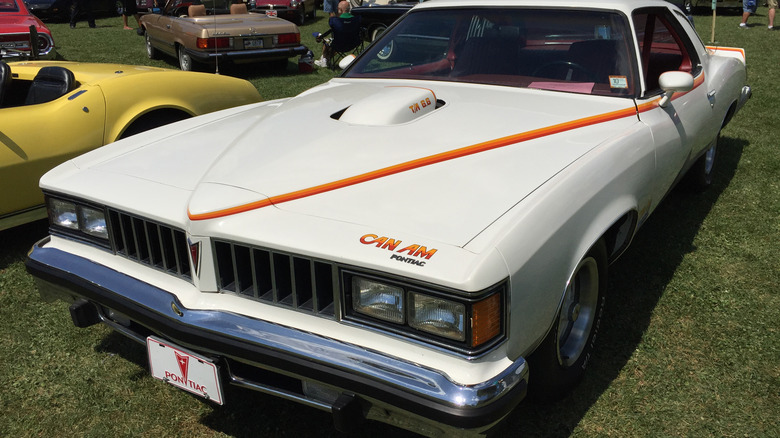
CZmarlin/Wikimedia
Vintage muscle cars are a favorite among automobile collectors. They represent that desire to be loud, fast, and stylish, blending the racing world with the everyday. Whether a 1969 Chevrolet Camaro or a 1970 Plymouth Road Runner Superbird, something about these vehicles has transcended generations and become objects people clamor to own. However, when it comes to muscle cars — particularly American ones — there’s one company that is the granddaddy of them all: Pontiac.
Pontiac introduced the GTO in 1964, and it was a sign to every other car company there was a hunger for a high-performance vehicle with a hulking V8 engine. Originally, the GTO was a package option for the Pontiac Tempest and LeMans models before eventually becoming a separate model. After the GTO hit the market, every company needed its own muscle car, which is why we saw such a boom in the marketplace over the late 1960s and 1970s.
In 1977, Pontiac debuted what could have been the next step in their muscle car trajectory, but its time in the sun was about as brief as a vehicle could have. That car is the Pontiac Can Am. This muscle car lasted only six months in production after being introduced midway through the production year and has been fairly lost to time, by and large. However, the Can Am was not some dud built by Pontiac.
[Image by CZmarlin via Wikimedia Commons | Cropped and scaled | CC BY 4.0]
The Pontiac LeMans and Grand Am
Gestalt Imagery/Shutterstock
The GTO was not the first optional trim available for the Pontiac Tempest. Before that, there was the Pontiac LeMans, which also became popular enough to be spun off into its own distinct model. The GTO option was also available for this car, where it truly flourished. This was a mid-size car that featured the 6.4 L V8 engine from the full-size Pontiac Catalina, which could generate 335 horsepower on the smaller vehicle, according to Carfolio.
About a decade after the introduction of the LeMans, Pontiac brought in another mid-size to their line called the Grand Am, a fusion of the Pontiac Grand Prix and Trans Am (a high-performance package for the Pontiac Firebird) models. Carfolio states this had a slightly larger engine than the LeMans with a 6.6 L V8. However, it was also an option that could get you a 7.5 L V8 for 250 hp. The big problem for the Grand Am was that it was introduced in 1973, coinciding with the major oil crisis of the time. This era was where efficiency became paramount for car buyers, and what the Grand Am had in power, it lacked in efficiency. Consequently, it was discontinued after two years.
With the Grand Am in the rearview mirror and the LeMans over a decade into its run, Pontiac was primed to introduce their new high-performance muscle car.
An extremely short lifespan
TropicDave/Wikimedia
As with most Pontiac performance vehicles, they were named after various races, like the Le Mans or Grand Prix. The Pontiac Can Am was no different, taking its name from the Canadian-American Challenge Cup. In the later years of the 1970s, the oil crisis had subsided, so Pontiac thought the Can Am could take off in the way that the Grand Am couldn’t.
The Can Am was technically a package available for the LeMans model, which not only came with a unique white and burnt orange stripe paint but also a new 6.6 L V8 engine that generated 200 horsepower, according to Auto Evolution. Even though the oil crisis wasn’t as big of a deal, efficiency was still an important factor, and the market for a car that could generate a staggering amount of horsepower was limited.
According to Motor Trend, the plan was to produce 5,000 Can Ams in the first year. However, that would not come to pass. The Can Ams were not on the standard Pontiac building line; instead, they were built at Motortown due to some specialty parts. After 1,000 cars had been produced, the machine for tooling the vehicles’ rear spoilers broke, and because there was no backup, it was either make the car with no spoiler or shut down Can Am operations. Pontiac chose the latter, ending it all six months after its debut to the world.
[Image by TropicDave via Wikimedia Commons | Cropped and scaled | CC BY 3.0]
The return of the Grand Am
Greg Gjerdingen/Wikimedia
The Can Am was introduced in January 1977 and was meant to replace the Grand Am, which ended in 1975. Because the pathway for the Can Am had been prematurely ended, Pontiac decided that the new replacement for the Grand Am would be the Grand Am. In 1978, Pontiac brought back their previously defunct vehicle. The first model year featured a V8 engine, quickly followed by a standard V6 replacement the next year. The life of this version of the Grand Am was about as long as the first one, and by 1980, it was all over. Five years later, Pontiac would bring back the Grand Am name again, but this was for a far less flashy compact vehicle.
Meanwhile, the Pontiac Can Am has never returned, whether as a revived model or just another car using the same name. It had a six-month lifespan and was taken out of commission solely because of circumstance. It never had a chance to establish a foothold in the popular car culture, and therefore, it has been somewhat lost to time. That being said, only 1,133 units of the Can Am were produced, so it is something of a rare item out in the marketplace. Perhaps it deserves some sort of second life.
[Image by Greg Gjerdingen via Wikimedia Commons | Cropped and scaled | CC BY 2.0]
>>> Read full article>>>
Copyright for syndicated content belongs to the linked Source : SlashGear – https://www.slashgear.com/1489563/pontiac-cam-am-guide/
